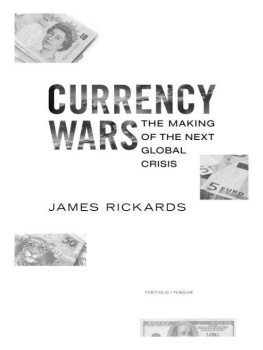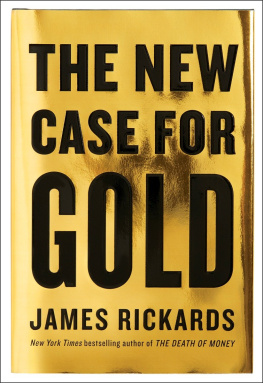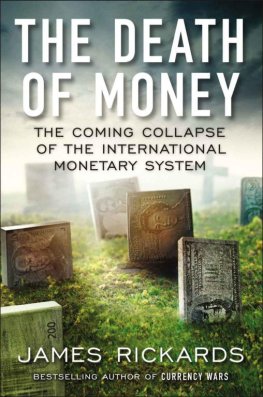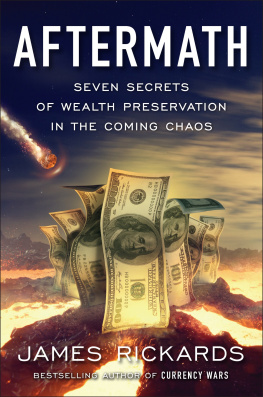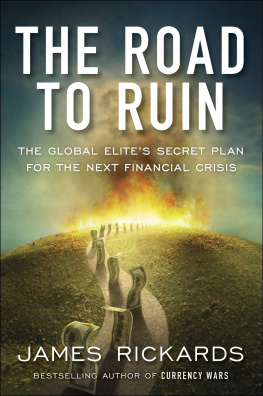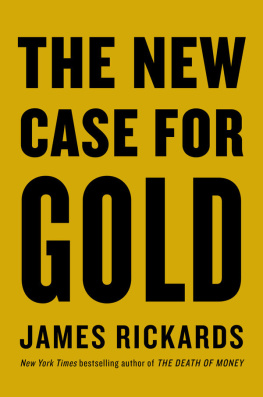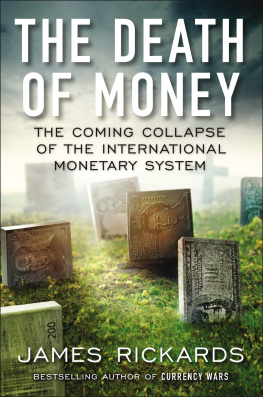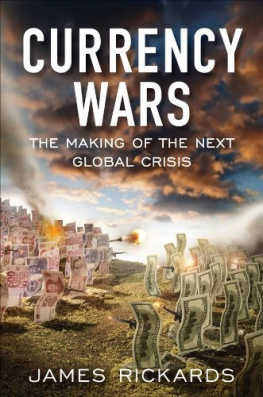AFTERMATH
Praise for The Road to Ruin
If you are curious about what the financial Gtterdmmerung might look like, youve certainly come to the right place. Rickards believes and provides tantalizing snippets of private conversations with those who dwell in the very eye in the pyramid that the current world monetary and financial system is on the verge of insolvency and that the world financial elites already have a successor system for which they are laying the groundwork Forbes
Praise for Currency Wars
The currency wars are heating up. This is a plausible way to view what is going on, and Rickards tells the tale well Financial Times
Rickards has written one of the scariest books Ive read this year. Though I was tempted at first to dismiss him as alarmist, his intelligent reasoning soon convinced me that we have more to fear than fear itself. Part history, part primer and analysis, the text covers topics ranging from the misuse of economics to complexity theory. The pieces, although disparate, fit together snugly, as in one of those mystery jigsaw puzzles that come with clues in lieu of cover art. The picture that emerges is dark yet comprehensive and satisfying Bloomberg Businessweek
Praise for The Death of Money
A fast-paced and apocalyptic look at the financial future, taking in financiers greed, central banks incompetence and impending Armageddon for the dollar. Rickards may be right that the system is going wobbly Financial Times
Praise for The New Case for Gold
Reminds us that wayward policies bring about a search for money that is good as gold. Whats better than gold itself? Wall Street Journal
Presents compelling evidence that many of the worlds leading monetary authorities implicitly, at least, treat gold as quite possibly in the future, the key money Forbes
James Rickards
AFTERMATH
Seven Secrets of Wealth Preservation in the Coming Chaos

PENGUIN BOOKS
UK | USA | Canada | Ireland | Australia
India | New Zealand | South Africa
Penguin Books is part of the Penguin Random House group of companies whose addresses can be found at global.penguinrandomhouse.com.

First published in the United States of America by Portfolio Penguin 2019
First published in Great Britain by Penguin Business 2019
Copyright James Rickards, 2019
While the author has made every effort to provide accurate telephone numbers, internet addresses and other contact information at the time of publication, neither the publisher nor the author assumes any responsibility for errors or for changes that occur after publication. Further, the publisher does not have any control over and does not assume any responsibility for author or third-party websites or their content
The moral right of the author has been asserted
Jacket photo illustration: C. J. Burton
ISBN: 978-0-241-98079-8
Follow us on LinkedIn: linkedin.com/company/penguinbusiness
This ebook is copyright material and must not be copied, reproduced, transferred, distributed, leased, licensed or publicly performed or used in any way except as specifically permitted in writing by the publishers, as allowed under the terms and conditions under which it was purchased or as strictly permitted by applicable copyright law. Any unauthorized distribution or use of this text may be a direct infringement of the authors and publishers rights and those responsible may be liable in law accordingly.
For Ann
Then I watched while the Lamb broke open the first of the seven seals, and I heard one of the four living creatures cry out in a voice like thunder, Come forward. I looked, and there was a white horse, and its rider had a bow. He was given a crown, and he rode forth victorious to further his victories.
Revelation 6:12

Introduction
No Way Home
This book is about the aftermath of the 2008 global financial crisis and efforts by central banks first to prevent a complete collapse of capital markets, later to revive self-sustaining growth, then finally to withdraw from continual policy intervention. It also warns that the crisis never really ended and offers a path to preserve wealth in the next phase. Like the Odyssey, this ten-year journey cannot be understood without reference to the struggle that preceded it. We consider the before, the after, and the future of the greatest financial crisis since the Great Depression.
In Homers epic poem the Odyssey, Scylla and Charybdis confront the hero, Odysseus, sailing home after the Trojan War. Scylla and Charybdis were the most feared women of Greek mythology. They lived in caves, a bowshot apart on each side of a narrow strait. Although female in nature, they were monsters. Scylla had six heads. Each mouth had rows of razor-sharp teeth that made the shark in Jaws seem tame. Her waist was shrouded with heads of baying dogs. She swam and walked on twelve snaky legs and devoured all within reach.
Less is known about the look of Charybdis, yet her powers were as daunting as Scyllas. Three times a day Poseidons daughter would swallow the sea and spew it out, creating a whirlpool fatal to ships and sailors.
Odysseus is faced with a terrible choice. He must guide his vessel through the strait. Avoiding one peril needs put him in reach of the other. Odysseus orders the crew to steer clear of Charybdis, taking his chances with Scylla. He reasons that a whirlpool portends complete loss, while Scylla is a more selective threatan ancient exercise in risk management. The gamble pays off. Scylla devours six of the crew. Still, Odysseus and the remnant survive, their vessel intact, to continue their journey home to Ithaca.
This heros dilemma, known in modern idiom as being between Scylla and Charybdis, is a perfect metaphor for the state of the global economy today and the choices confronting policymakers. Odysseus could coolly calculate his choice based on the nature of the horrors he confronted. Policymakers face similar tough choices now, with no way to gauge which is worse. The history of central bank policy since 2008 is an odyssey back to normalized interest rates and balance sheets. In the original Odyssey, the hero eventually arrives home, despite the dangers. In 2019, central bankers are still wandering, their travels far from over.
This twenty-first-century central bank odyssey was preceded by its own version of the Trojan War. In 2000, Federal Reserve chairman Alan Greenspan faced four challenges in quick succession that caused near deflation. The first was the bursting of the dot-com stock bubble beginning in March 2000. Second was a cyclical recession beginning in the United States in March 2001, part of a global slowdown in developed economies. Third were the 9/11 attacks, which, in addition to their historic geopolitical consequences, caused $40 billion in insurance losses and a one-day 7.1 percent stock market decline. This decline followed the longest trading suspension, September 1114, 2001, since 1933. Finally, Chinas accession to full WTO membership in December 2001 opened world markets to the greatest agglomeration of cheap labor and abundant capital in history. Chinas emergence put downward pressure on prices that has not abated.


